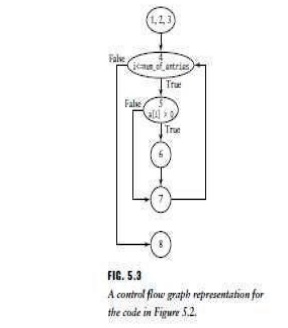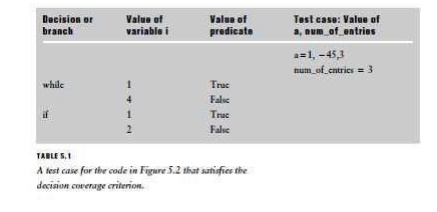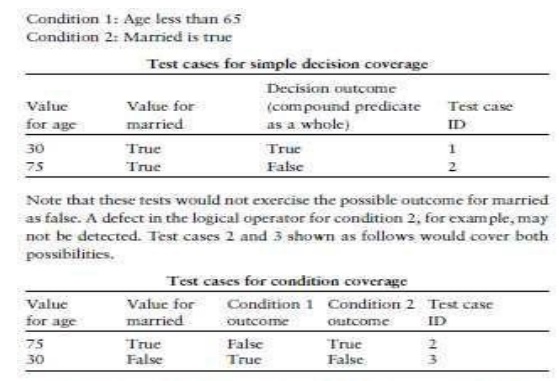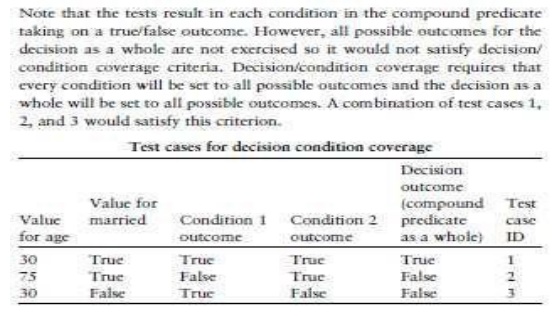Chapter: Software Testing : Test Case Design
Covering Code Logic
Covering Code Logic
Logic-based white box-based test design and use of test data adequacy/ coverage concepts provide two major payoffs for the tester:
(i) quantitative coverage goals can be proposed, and
(ii) commercial tool support is readily available to facilitate the tester‘s work .
As
described in Section 5.1, testers can use these concepts and tools to decide on
the target logic elements (properties or features of the code) and the degree
of coverage that makes sense in terms of the type of software, its mission or
safety criticalness, and time and resources available. For ex ample, if the
tester selects the logic element program statements, this indicates that she
will want to design tests that focus on the execution of program statements. If
the goal is to satisfy the statement adequacy/ coverage criterion, then the
tester should develop a set of test cases so that when the module is executed,
all (100%) of the statements in the module are executed at least once. In terms
of a flow graph model of the code, satisfying this criterion requires that all
the nodes in the graph are exercised at least once by the test cases. For the
code in Figure 5.2 and its corresponding flow graph in Figure 5.3 a tester
would have to develop test cases that exercise nodes 1-8 in the flow graph. If
the tests achieve this goal, the test data would satisfy the statement adequacy
criterion. In addition to statements, the other logic structures are also
associated with corresponding adequacy/coverage criteria. For example, to
achieve complete (100%) decision (branch) coverage test cases must be designed
/*
pos_sum nds the sum of all positive numbers (greater than zero) stored in an
integer
array a.
Input parameters are num_of_entries, an integer, and a, an array of integers
with num_of_entries elements. The output parameter is the integer sume */
1. pos_sum(a, num_of_entries, sum)
2. sum 0
3. inti 1
4. while (i < num_of_entries)
5. if a[i] > 0
6.
sum sum
a[i]
endif
7. i = i
+ 1
end while
8. end pos_sum
FIG. 5.2 Code
sample with branch and loop.
so that
each decision element in the code (if-then, case, loop) executes with all
possible outcomes at least once. In terms of the control flow model, this
requires that all the edges in the corresponding flow graph must be exercised
at least once. Complete decision coverage is considered to be a stronger
coverage goal than statement coverage since its satisfaction results in satisfying
statement coverage as well (covering all the edges in a flow graph will ensure
coverage of the nodes). In fact, the statement coverage goal is so weak that it
is not considered to be very useful for revealing defects. For example, if the
defect is a missing statement it may remain undetected by tests satisfying
complete statement coverage. The reader should be aware that in spite of the
weakness, even this minimal coverage goal is not required in many test plans.
Decision (branch) coverage for the code example in Figure 5.2, requires test
cases to be developed for the two decision statements, that is, the four
true/false edges in the control flow graph of Figure 5.3. Input values must
ensure execution the true/false possibilities for the decisions in line 4
(while loop) and line 5 (if statement). Note that the if statement has a full
else component, that is, there is no else part. However, we include a test that
covers both the true and false conditions for the statement.

A possible
test case that satisfies 100% decision coverage is shown in Table 5.1. The
reader should note that the test satisfies both the branch adequacy criterion
and the statement adequacy criterion, since all the statements 1-8 would be
executed by this test case. Also note that for this code example, as well as
any other code component, there may be several sets of test cases that could
satisfy a selected criterion. This code example represents a special case in
that it was feasible to achieve both branch and statement coverage with one
test case. Since one of the inputs, , is an array, it was possible to assign
both positive and negative values to the elements of , thus allowing coverage
of both the true/false branches of the if statement. Since more than one iteration
of the while loop was also possible, both the true and false branches of this
loop could also be covered by one test case. Finally, note that the code in the
example does not contain any checks on the validity of the input parameters.
For simplicity it is assumed that the calling module does the checking.
In Figure
5.2 we have simple predicates or conditions in the branch and loop
instructions. However, decision statements may contain multiple conditions, for
example, the statement
If (x MIN
and y MAX and (not INT Z))
has three
conditions in its predicate: (i) x MIN, (ii) y MAX, and (iii) not INT Z.
Decision coverage only requires that we exercise at least once all the possible
outcomes for the branch or loop predicates as a whole, not for each individual condition contained in a compound predicate.
There are other coverage criteria requiring at least one execution of the all
possible conditions and combinations of decisions/conditions. The names of the
criteria reflect the extent of condition/decision coverage. For example,
condition coverage requires that the tester insure that each individual
condition in a compound predicate takes on all possible values at least once
during execution of the test cases. More stringent coverage criteria also require
exercising all possible combinations of decisions and conditions in the code.
All of the coverage criterion described so far can be arranged in a hierarchy
of strengths from weakest to strongest as follows: statement, decision,
decision/condition. The implication for this approach to test design is that
the stronger the criterion, the more defects will be revealed by the tests.
Below is a simple example showing the test cases for a decision statement with
a compound predicate.

if(age
<65 and married true) do X
do Y
.........
else
do Z


The
criteria described above do not require the coverage of all the possible
combinations of conditions. This is represented by yet another criterion called
multiple condition coverage where all possible combinations of condition
outcomes in each decision must occur at least once when the test cases are
executed. That means the tester needs to satisfy the following combinations for
the example decision statement:
Condition 1 Condition 2
True True
True False
False True
False False
In most
cases the stronger the coverage criterion, the larger the number of test cases
that must be developed to insure complete coverage. For code with multiple
decisions and conditions the complexity of test case design increases with the
strength of the coverage criterion. The tester must decide, based on the type
of code, reliability requirements, and resources available which criterion to
select, since the stronger the criterion selected the more resources are usually
required to satisfy it.
Related Topics